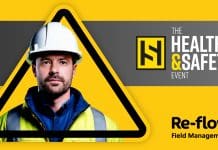Paul Haxell, Chair of the Institution of Occupational Safety and Health (IOSH) Construction Group outlines the risks of working at height and what mitigation steps should be taken.
There continues to be a high level of fatalities caused by falls within the construction industry, according to the latest Health and Safety Executive (HSE) statistics.
Some 59% of construction fatalities – 23 deaths – were caused by falls in 2012/13. Over the same period, 28% of reported major injuries and a further 12% reported over a 7-day absence are caused by falls from height. In total, some 920 injuries in construction were caused by falls.
The law, Work at Heights Regulation 2005, requires that employees and the self-employed undertake a risk assessment for all work at heights. The risk assessment should then inform the development of a safe working method which is planned, communicated to employers and implemented in the workplace.
A specific hierarchy of controls exists to mitigate the risks of working at height. In priority order, the following are to be applied:
- Avoid work at height where it is reasonably practicable to do so.
- Where work at height cannot be avoided, prevent falls using either an existing place of work that is already safe, or the right type of equipment.
- Minimise the distance and consequences of a fall, by using the right type of equipment where risks cannot be eliminated.
Around 1 in 5 deaths in construction involve roof work. Some of those killed are specialist roofers whilst others are involved in routine maintenance, like gutter cleaning and minor repairs.
Of those deaths and major injuries caused by roofing, falls from the roof through openings, off edges or through fragile surfaces are the main causes. Many of these accidents would have been prevented through the use of suitable equipment and if those doing the work had been given adequate information, instruction and training.
Safe access to a roof requires careful planning, particularly where work progresses along the roof.
Typical methods to access roofs are:
- General access scaffolds;
- Stair towers;
- Fixed or mobile scaffold towers;
- Mobile access equipment;
- Ladders; and Roof access hatches.
- MEWP’s
Falls from roof edges occur on both commercial and domestic projects and on new build and refurbishment jobs. Many deaths occur each year involving smaller building operatives working on the roof of domestic dwellings.
Sloping roofs require scaffolding to prevent people or materials falling from the edge. You must also fit edge protection to the eaves of any roof and on terraced properties to the rear, as well as the front. Where work is of short duration, (tasks measured in minutes), properly secured ladders to access the roof and proper roof ladders may be used.
Falls from flat roof edges can be prevented by simple edge protection arrangements – a secure double guardrail and toe board around the edge.
All roofs should be treated as fragile until a competent person has confirmed they are not. Do not trust any sheeted roof, whatever the material, to bear the weight of a person. This includes the roof ridge and purlins.
Fragile roof lights are a particular hazard. Some are difficult to see in certain light conditions and others may be hidden by paint. ■
. . . . . . . . . . . . . . . . . . . . . . . . . . . . . . . . . . . . . . . . . . . . . . .
Paul Haxell
Chair of the Construction Group
Institution of Occupational Safety and Health (IOSH)
Tel: +44 (0)116 257 3100













